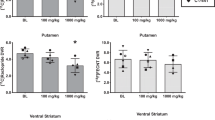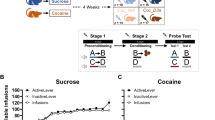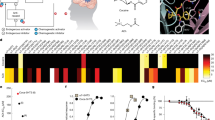Abstract
The trace amine-associated receptor 1 (TAAR1) has emerged as a promising target for medication development in addiction because of its ability to regulate dopamine (DA) transmission. We tested in rats the efficacy of RO5203648 and RO5256390, partial and full TAAR1 agonists, respectively, in models of cocaine relapse. Using a model of context-induced relapse, both RO5203648 and RO5256390 dose-dependently suppressed cocaine seeking after a 2-week period of withdrawal from chronic cocaine self-administration. In a model of extinction-reinstatement, RO5203648 completely inhibited cocaine-primed reinstatement of cocaine seeking. At doses that effectively suppressed cocaine seeking neither RO5203648 nor RO5256390 altered responding maintained by a natural reward. Moreover, fast scan cyclic voltammetry data showed that RO5203648 prevented cocaine-induced DA overflow in the nucleus accumbens without altering DA half-life, suggesting that the partial TAAR1 agonist attenuated cocaine-stimulated DA overflow by mechanisms other than direct interference with DA uptake. Collectively, these data provide strong evidence in support of TAAR1 as a neuropharmacological target for the treatment of cocaine addiction.
Similar content being viewed by others
Log in or create a free account to read this content
Gain free access to this article, as well as selected content from this journal and more on nature.com
or
References
Berry MD (2004). Mammalian central nervous system trace amines. Pharmacologic amphetamines, physiologic neuromodulators. J Neurochem 90: 257–271.
Berry MD (2007). The potential of trace amines and their receptors for treating neurological and psychiatric diseases. Rev Recent Clin Trials 2: 3–19.
Borowsky B, Adham N, Jones KA, Raddatz R, Artymyshyn R, Ogozalek KL et al (2001). Trace amines: identification of a family of mammalian G protein-coupled receptors. Proc Natl Acad Sci USA 98: 8966–8971.
Bradaia A, Trube G, Stalder H, Norcross RD, Ozmen L, Wettstein JG et al (2009). The selective antagonist EPPTB reveals TAAR1-mediated regulatory mechanisms in dopaminergic neurons of the mesolimbic system. Proc Natl Acad Sci USA 106: 20081–20086.
Bunzow JR, Sonders MS, Arttamangkul S, Harrison LM, Zhang G, Quigley DI et al (2001). Amphetamine, 3,4-methylenedioxymethamphetamine, lysergic acid diethylamide, and metabolites of the catecholamine neurotransmitters are agonists of a rat trace amine receptor. Mol Pharmacol 60: 1181–1188.
Cornish JL, Kalivas PW (2000). Glutamate transmission in the nucleus accumbens mediates relapse in cocaine addiction. J Neurosci 20: RC89.
de WH, Stewart J (1981). Reinstatement of cocaine-reinforced responding in the rat. Psychopharmacology (Berl) 75: 134–143.
Espinoza S, Salahpour A, Masri B, Sotnikova TD, Messa M, Barak LS et al (2011). Functional interaction between trace amine-associated receptor 1 and dopamine D2 receptor. Mol Pharmacol 80: 416–425.
Ferragud A, Velazquez-Sanchez C, Hernandez-Rabaza V, Nacher A, Merino V, Carda M et al (2009). A dopamine transport inhibitor with markedly low abuse liability suppresses cocaine self-administration in the rat. Psychopharmacology (Berl) 207: 281–289.
Fontana DJ, Post RM, Pert A (1993). Conditioned increases in mesolimbic dopamine overflow by stimuli associated with cocaine. Brain Res 629: 31–39.
Fuchs RA, Branham RK, See RE (2006). Different neural substrates mediate cocaine seeking after abstinence versus extinction training: a critical role for the dorsolateral caudate-putamen. J Neurosci 26: 3584–3588.
Grandy DK (2007). Trace amine-associated receptor 1-family archetype or iconoclast? Pharmacol Ther 116: 355–390.
Greco PG, Garris PA (2003). In vivo interaction of cocaine with the dopamine transporter as measured by voltammetry. Eur J Pharmacol 479: 117–125.
Hearing MC, Miller SW, See RE, McGinty JF (2008a). Relapse to cocaine seeking increases activity-regulated gene expression differentially in the prefrontal cortex of abstinent rats. Psychopharmacology (Berl) 198: 77–91.
Hearing MC, See RE, McGinty JF (2008b). Relapse to cocaine-seeking increases activity-regulated gene expression differentially in the striatum and cerebral cortex of rats following short or long periods of abstinence. Brain Struct Funct 213: 215–227.
John CE, Jones SR (2007). Voltammetric characterization of the effect of monoamine uptake inhibitors and releasers on dopamine and serotonin uptake in mouse caudate-putamen and substantia nigra slices. Neuropharmacology 52: 1596–1605.
Kalivas PW (2008). Addiction as a pathology in prefrontal cortical regulation of corticostriatal habit circuitry. Neurotox Res 14: 185–189.
Kalivas PW, McFarland K (2003). Brain circuitry and the reinstatement of cocaine-seeking behavior. Psychopharmacology (Berl) 168: 44–56.
Karila L, Petit A, Lowenstein W, Reynaud M (2012). Diagnosis and consequences of cocaine addiction. Curr Med Chem 19: 5612–5618.
Kawagoe KT, Zimmerman JB, Wightman RM (1993). Principles of voltammetry and microelectrode surface states. J Neurosci Methods 48: 225–240.
Koob GF, Le MM (2001). Drug addiction, dysregulation of reward, and allostasis. Neuropsychopharmacology 24: 97–129.
Kuhr WG, Wightman RM (1986). Real-time measurement of dopamine release in rat brain. Brain Res 381: 168–171.
Ledonne A, Federici M, Giustizieri M, Pessia M, Imbrici P, Millan MJ et al (2010). Trace amines depress D(2)-autoreceptor-mediated responses on midbrain dopaminergic cells. Br J Pharmacol 160: 1509–1520.
Lewin AH, Miller GM, Gilmour B (2011). Trace amine-associated receptor 1 is a stereoselective binding site for compounds in the amphetamine class. Bioorg Med Chem 19: 7044–7048.
Lindemann L, Ebeling M, Kratochwil NA, Bunzow JR, Grandy DK, Hoener MC (2005). Trace amine-associated receptors form structurally and functionally distinct subfamilies of novel G protein-coupled receptors. Genomics 85: 372–385.
Lindemann L, Hoener MC (2005). A renaissance in trace amines inspired by a novel GPCR family. Trends Pharmacol Sci 26: 274–281.
Lindemann L, Meyer CA, Jeanneau K, Bradaia A, Ozmen L, Bluethmann H et al (2008). Trace amine-associated receptor 1 modulates dopaminergic activity. J Pharmacol Exp Ther 324: 948–956.
McFarland K, Lapish CC, Kalivas PW (2003). Prefrontal glutamate release into the core of the nucleus accumbens mediates cocaine-induced reinstatement of drug-seeking behavior. J Neurosci 23: 3531–3537.
Melis M, Spiga S, Diana M (2005). The dopamine hypothesis of drug addiction: hypodopaminergic state. Int Rev Neurobiol 63: 101–154.
Miller GM, Verrico CD, Jassen A, Konar M, Yang H, Panas H et al (2005). Primate trace amine receptor 1 modulation by the dopamine transporter. J Pharmacol Exp Ther 313: 983–994.
Park WK, Bari AA, Jey AR, Anderson SM, Spealman RD, Rowlett JK et al (2002). Cocaine administered into the medial prefrontal cortex reinstates cocaine-seeking behavior by increasing AMPA receptor-mediated glutamate transmission in the nucleus accumbens. J Neurosci 22: 2916–2925.
Phillips PE, Stuber GD, Heien ML, Wightman RM, Carelli RM (2003). Subsecond dopamine release promotes cocaine seeking. Nature 422: 614–618.
Reese EA, Norimatsu Y, Grandy MS, Suchland KL, Bunzow JR, Grandy DK (2014). Exploring the determinants of trace amine-associated receptor 1's functional selectivity for the stereoisomers of amphetamine and methamphetamine. J Med Chem 57: 378–390.
Revel FG, Meyer CA, Bradaia A, Jeanneau K, Calcagno E, Andre CB et al (2012a). Brain-specific overexpression of trace amine-associated receptor 1 alters monoaminergic neurotransmission and decreases sensitivity to amphetamine. Neuropsychopharmacology 37: 2580–2592.
Revel FG, Moreau JL, Gainetdinov RR, Bradaia A, Sotnikova TD, Mory R et al (2011). TAAR1 activation modulates monoaminergic neurotransmission, preventing hyperdopaminergic and hypoglutamatergic activity. Proc Natl Acad Sci USA 108: 8485–8490.
Revel FG, Moreau JL, Gainetdinov RR, Ferragud A, Velazquez-Sanchez C, Sotnikova TD et al (2012b). Trace amine-associated receptor 1 partial agonism reveals novel paradigm for neuropsychiatric therapeutics. Biol Psychiatry 72: 934–942.
Revel FG, Moreau JL, Pouzet B, Mory R, Bradaia A, Buchy D et al (2013). A new perspective for schizophrenia: TAAR1 agonists reveal antipsychotic- and antidepressant-like activity, improve cognition and control body weight. Mol Psychiatry 18: 543–556.
Richardson NR, Roberts DC (1996). Progressive ratio schedules in drug self-administration studies in rats: a method to evaluate reinforcing efficacy. J Neurosci Methods 66: 1–11.
Schenk S, Hely L, Gittings D, Lake B, Daniela E (2008). Effects of priming injections of MDMA and cocaine on reinstatement of. Drug Alcohol Depend 96: 249–255.
Velazquez-Sanchez C, Ferragud A, Ramos-Miguel A, Garcia-Sevilla JA, Canales JJ (2013). Substituting a long-acting dopamine uptake inhibitor for cocaine prevents relapse to cocaine seeking. Addict Biol 18: 633–643.
Xie Z, Miller GM (2007). Trace amine-associated receptor 1 is a modulator of the dopamine transporter. J Pharmacol Exp Ther 321: 128–136.
Xie Z, Westmoreland SV, Bahn ME, Chen GL, Yang H, Vallender EJ et al (2007). Rhesus monkey trace amine-associated receptor 1 signaling: enhancement by monoamine transporters and attenuation by the D2 autoreceptor in vitro. J Pharmacol Exp Ther 321: 116–127.
Yorgason JT, Espana RA, Jones SR (2011). Demon voltammetry and analysis software: analysis of cocaine-induced alterations in dopamine signaling using multiple kinetic measures. J Neurosci Methods 202: 158–164.
Acknowledgements
This work was supported by grants to JJC from the Spanish Ministry of Health (ISCIII, grant PI10/00297), the Lottery Health Board of New Zealand (Ministry of Internal Affairs), and the Department of Psychology, University of Canterbury, New Zealand, and grants to RRG from the Fondazione Compagnia di San Paolo (Torino, Italy) and F Hoffman-La Roche.
Author information
Authors and Affiliations
Corresponding author
Rights and permissions
About this article
Cite this article
Pei, Y., Lee, J., Leo, D. et al. Activation of the Trace Amine-Associated Receptor 1 Prevents Relapse to Cocaine Seeking. Neuropsychopharmacol 39, 2299–2308 (2014). https://doi.org/10.1038/npp.2014.88
Received:
Revised:
Accepted:
Published:
Issue date:
DOI: https://doi.org/10.1038/npp.2014.88
This article is cited by
-
Improved cognitive performance in trace amine-associated receptor 5 (TAAR5) knock-out mice
Scientific Reports (2022)
-
TAAR1 regulates drug-induced reinstatement of cocaine-seeking via negatively modulating CaMKIIα activity in the NAc
Molecular Psychiatry (2022)
-
Selective TAAR1 agonists induce conditioned taste aversion
Psychopharmacology (2022)
-
Potential of Ligands for Trace Amine-Associated Receptor 1 (TAAR1) in the Management of Substance Use Disorders
CNS Drugs (2021)
-
TAAR Agonists
Cellular and Molecular Neurobiology (2020)



